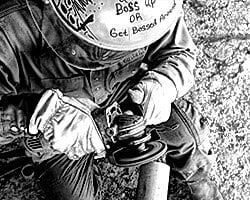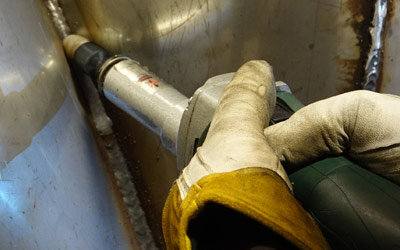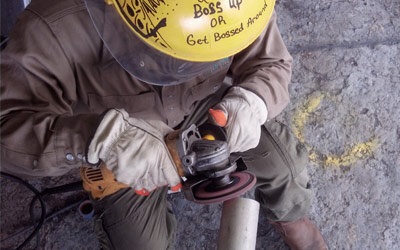Stainless Steel: The Best Products for Cutting, Grinding and Finishing

Stainless Steel: The Best Products for Cutting, Grinding, and Finishing
By Tony Hufford, category manager – metal fabrication, Weiler Abrasives Group
Sept 10, 2020
People use stainless steel for several reasons, including its mechanical properties and appearance. However, if you’re like most, the first thing that comes to mind is its corrosion resistance, which makes it very desirable for many applications. For example, stainless steel is used in the food, medical, construction, automotive, and marine industries just to name a few.
Stainless steel is typically more expensive than carbon steel, so it is critical to choose the right abrasive and utilize proper storage. Doing so can significantly improve production efficiency, lower rework costs, and reduce material waste.
The two most common grades of stainless steel used in the industrial market are 304 and 316. Both have a high percentage of chromium, which forms the protective barrier that gives stainless steel its name. However, 316 is more resistant to chlorides (seawater, salts) due to the addition of molybdenum. It also costs significantly more than 304, so it is primarily used in more niche applications or as needed where the value of it can be realized.
Addressing the challenges of stainless steel
Stainless steel is more difficult to grind than carbon steel, so it is critical to use the right products and follow some simple guidelines to get the job done correctly. Choosing the right product not only increases operator efficiency, but it can also reduce rework, improve finish, and eliminate the risk of cross or general contamination. In the end, that adds up to overall cost savings.
overall cost savings.
Many companies utilize both carbon and stainless steel in their manufacturing operations. One of the biggest concerns is the potential for cross-contamination. Stainless steel can become contaminated in many ways, the most frequent of which is by exposing it to iron by using the wrong product. For example, cleaning or finishing with a carbon steel brush on stainless steel may leave a residue because of the iron in carbon steel, leading to rust color (after rust) on the surface of those pieces. When that happens, the stainless steel itself may not be rusted, but the piece is still considered to be contaminated and the anti-corrosion properties will be diminished.
Cross-contamination is avoidable. Marking products to distinguish them can be valuable, as can splitting operations in the manufacturing facility between a carbon and stainless steel side. Limiting operator access to storage areas can also help. Remember to always avoid storing a carbon brush next to a stainless steel brush where they could come into contact with each other. Similarly, do not use a stainless steel brush that has been previously used on carbon steel.
It is important to note that contaminated stainless steel may not always immediately show it has been contaminated. Sometimes it isn’t until the material is exposed to moisture that the oxidation of surface contaminates begins to occur. This makes it all the more critical to take the extra steps to avoid costly cross-contamination in the first place.
Heat discoloration is another potential issue that can arise when cutting, grinding, or finishing stainless steel. If an operator builds up too much heat, it can result in heat discoloration in the metal that almost resembles an “oil spill.” When this happens, most of the time the heat discoloration must be finished out of the stainless steel, requiring an extra step that costs both time and money. To help mitigate this problem, there are abrasive grains and coatings that allow operators to either use less pressure, reduce surface friction, or both.
Selecting a product
All the same basic styles of abrasive products are used when cleaning, finishing, cutting, and grinding stainless as they are on carbon steel. There are, however, a number of differences in the makeup of those products that make their use easier and more productive.
For instance:
- Coated abrasives designed for stainless steel typically have an extra coating layer or “topcoat” that helps reduce heat buildup.
- Cutting and grinding wheels (and other abrasives) will have a special formulation and be labeled contaminant-free or INOX, meaning they are manufactured with additives that contain <.01% certain elements such as iron, sulfur & chlorine.
- Wire brushes will have stainless steel wires that do the cleaning.
Wire brushes are often the best choice when cleaning of welds or material surface is required. Remember, wire brushes don’t remove base material, so the dimensions of a part remain true. Also, let the wire tips do the work, as excessive pressure leads to premature wire failure and shorter brush life. Choose stainless steel wire brushes with a twisted knot design for more aggression and a crimped design for better surface area coverage.
 Abrasive products are commonly used for cutting, grinding, and finishing. Products specifically designed for INOX and/or that contain ceramic grains are the best options for most applications.
Abrasive products are commonly used for cutting, grinding, and finishing. Products specifically designed for INOX and/or that contain ceramic grains are the best options for most applications.
For cutting, .045 inch diameter wheels are still the most popular; however, 1-millimeter wheels are gaining traction in the market. Because they are slightly thinner, these wheels help minimize heat buildup and waste during the cutting process. As a rule of thumb, the thinner the cut, the faster the cut and less material must be removed — an important detail when working with more expensive material like stainless steel. Also, utilizing proper technique like a slight sawing motion with minimal depth of cut can help maximize wheel life and cut efficiency.
Grinding wheels are a great product for removing a lot of material quickly. They don’t typically leave as smooth of a finish as other abrasive products, but they get the job done fast. If the application does not require a specific finish, this type of product may be best suited for the application. Always start grinding with a pullback motion instead of a push to reduce the chance of gouging this expensive material.
Flap discs are another popular choice for working with stainless steel because they grind and finish the workpiece in a single step. This eliminates the need for product changeovers and saves time and money in the process. While flap discs may cost a little more upfront, they can typically add more value in the long term. These types of discs are also more forgiving to less experienced operators, adding value and efficiency.
At the end of the day, you need to find the right product for your applications. Using some of the tips here can help narrow down the choices. Remember, when working with stainless steel, never cut corners when selecting or storing products for the job. Given that stainless steel is expected to yield specific performance characteristics and is typically used on higher valued parts, the wrong choice can damage the material and may end up costing you a lot more in the long term.
